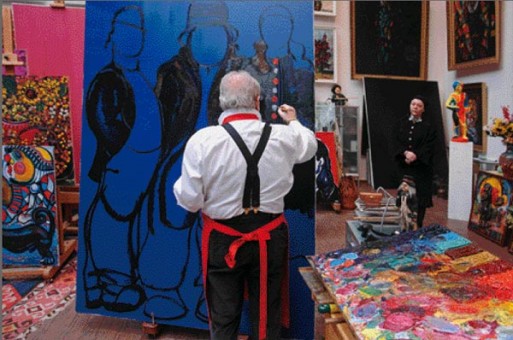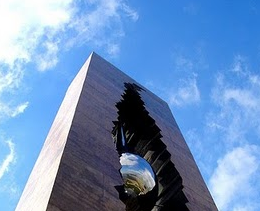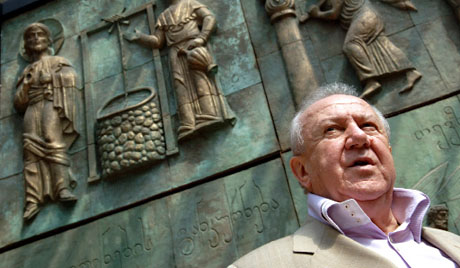In 2006, Bayonne, New Jersey was gifted a monument in memoriam of 9/11 by Russian President Vladimir Putin. Known as “The Teardrop Monument,” or the “Tear Of Grief,” the towering sculpture was gifted to the US after it’s completion by Russian artist Zurab Tsereteli. The bronze plated memorial is over 100 feet tall, with a glimmering, 40 foot tear drop suspended in its cracked center. It makes for a very dramatic, imposing image on the city’s skyline – so how come it received so little media coverage?
Zurab Tsereteli was in Moscow, Russia on September 11th, 2001. And like so many countless others, he was stopped in his tracks as he was getting ready for work by the news of terrorist attacks. “Like the rest of the world,” says the memorial’s official site, “[Tsereteli] was glued to coverage of the attacks on the Twin Towers. He was moved to tears.”
As president of the Russian Academy of Arts and a UNESCO Goodwill Ambassador, Tsereteli immediately got to work designing a monument in memoriam of the tragic 9/11 deaths. “He set to work that day,” says the site, “[set on finding] a proper and appropriate form through which to express his feelings over the attack.”
Evidently, Tsereteli took the inspiration from his tears quite literally, realizing his tear trop memorial with the intent of gifting it to New Jersey. He says he chose New Jersey because he wanted a location where “the monument could be on the waterfront and settled on a never before seen area of the peninsula at Bayonne…[there], the World Trade Center [would be] the backdrop to the waterfront, and so, the backdrop of life.” A simple enough gesture – right? Not for New Jersey artist Leon Yost. “It’s insensitive, it’s heavy-handed, it’s simplistic, it’s a cliché, other than that, what’s not to like?” said Yost said about the sculpture. He’s not alone in his dislike of Tsereteli’s work; many have been calling the teardrop another addition to Tsereteli’s string of controversial sculptures (i.e. a 300 foot tall Columbus). A Jersey City arts group even dubbed it ”an insensitive, self-aggrandizing piece of pompousness by one of the world’s blatant self-promoters.’
This latter criticism reaches a territory far more sensitive than artistic opinion, recalling a history of violent tension between the US and Russia. ”It’s like planting the flag on Iwo Jima, right across the river from where the attacks took place,” said the former co-chairman of the 9/11 committees, Guy Catrillo about the sculpture.
Naturally, slews of conspiracy theories mounted regarding Tsereteli’s intent behind the sculpture. “It was an insult!” or “It’s a monstrous size on purpose!” were some of the most popular complaints.
How can the average citizen judge Tsereteli’s work? At this point, I believe the answer is simple: however they like. Hate it? Fine. Love it? That’s fine too. I can only speak from my place as a quotidian citizen, and one who has no connections with politicians or journalists who could do some probing for the “real” scoop– but would that really help? Would holding onto that anger really aid the grieving process? The teardrop sculpture has been received as gift of peace, and I think we’d be arguably better off to just accept this perspective, and move on. Ultimately, the role the viewer chooses to let it play in their life is up to them.
You may like:
- SevenPonds Videos: Remembering 9/11
- Something Special: SevenPonds Shares Nationwide Events to Commemorate 9/11
- In Remembrance of 9/11: The Bead Quilt

 In Memoriam of 9/11: New Jersey’s Teardrop Sculpture
In Memoriam of 9/11: New Jersey’s Teardrop Sculpture





 John Mulaney’s “Funeral Planning” on Netflix: No Real Plan
John Mulaney’s “Funeral Planning” on Netflix: No Real Plan

 Composting Bodies Is Now Legal in a Dozen States
Composting Bodies Is Now Legal in a Dozen States














